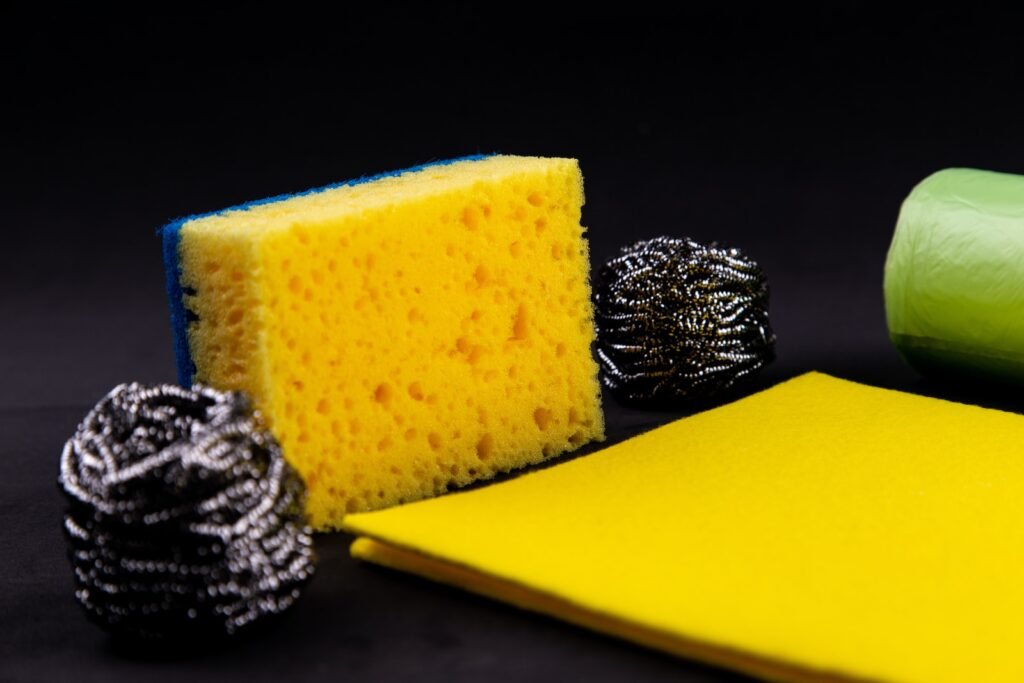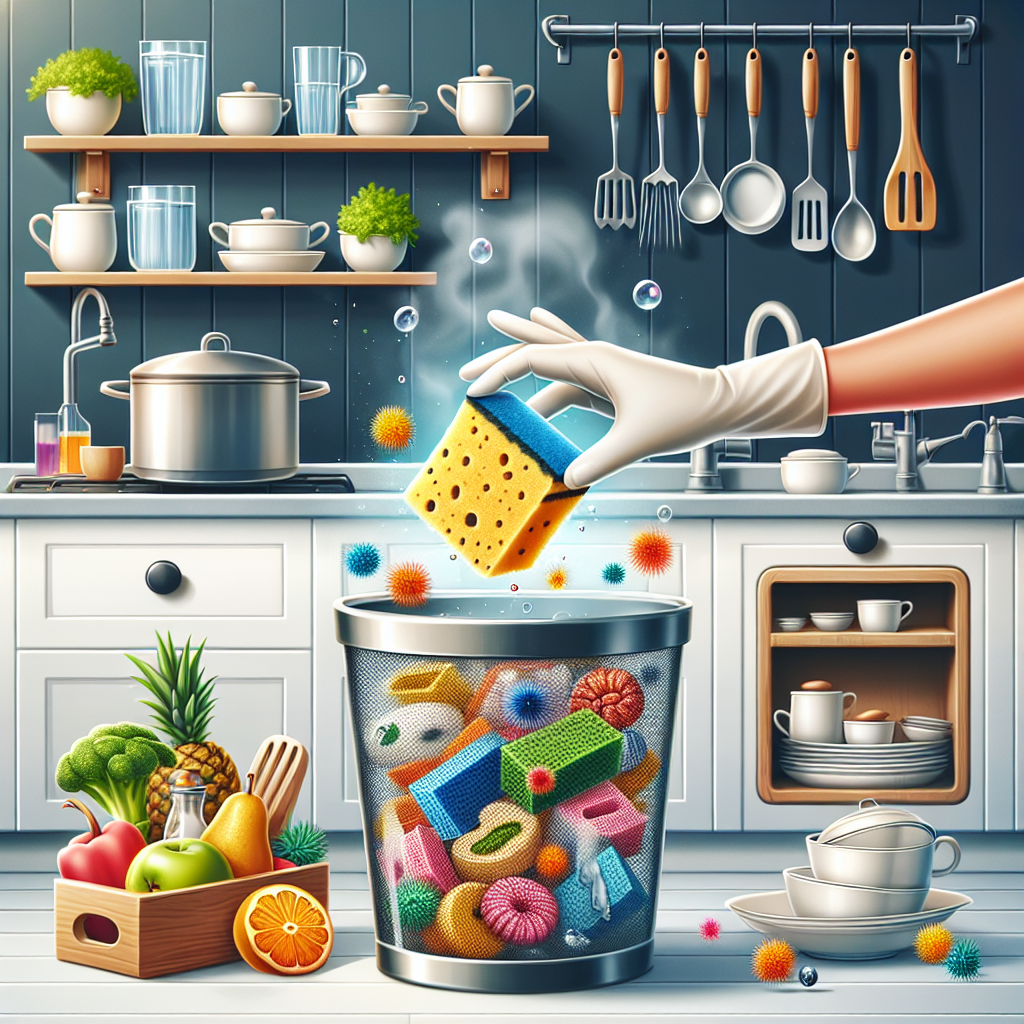Have you ever wondered how often you should replace your kitchen sponges? Well, you’re not alone! Kitchen sponges are an essential tool in every home, but they can also become a breeding ground for bacteria if not replaced regularly. In this article, we will explore the lifespan of a kitchen sponge and provide you with some useful tips on how to determine when it’s time to toss out that old sponge and grab a fresh one. So, let’s dive in and discover the secrets to keeping your kitchen sponges clean and germ-free!
Why Replace Kitchen Sponges?
Understanding the Importance of Replacing Kitchen Sponges
Keeping your kitchen clean and hygienic is essential for maintaining good health. One often overlooked item in our kitchens is the humble sponge. Many of us use sponges daily without realizing the potential health risks they can pose if not properly maintained and replaced regularly. This article aims to shed light on the importance of replacing kitchen sponges and provide you with helpful tips to ensure a clean and safe kitchen environment.
Health Risks Associated with Dirty Sponges
As we use kitchen sponges to scrub dishes, countertops, and other surfaces, they inevitably come into contact with food particles, grease, and potentially harmful bacteria. If not cleaned and replaced regularly, these sponges become a breeding ground for bacteria, which can lead to foodborne illnesses and other health issues. Studies have shown that kitchen sponges can harbor a wide range of bacteria, including E.coli and Salmonella, posing a threat to you and your family’s well-being.
Bacterial Growth on Sponges
Sponges provide an ideal environment for bacteria to thrive. The moist and porous nature of sponges provides ample opportunity for bacteria to multiply. When we use sponges to clean dirty surfaces, bacteria can easily get trapped within the sponge’s tiny crevices. If the sponge is not properly cleaned and sanitized, this bacteria multiplies rapidly, increasing the risk of contamination with each use.
Factors to Consider
Type of Sponge Material
When considering how often to replace your kitchen sponge, it’s important to take into account the type of material it is made of. Different sponge materials have varying durability and resistance to bacterial growth. Cellulose sponges, for example, are made from wood pulp and are biodegradable but tend to break down more quickly. On the other hand, synthetic sponges, such as those made from nylon or polyester, may last longer but can also harbor more bacteria. Considering the material of your sponge is crucial in determining its lifespan and replacement frequency.
Frequency of Use
The more frequently you use your kitchen sponge, the faster it will wear out and become prone to bacterial growth. If you frequently cook and clean, you may need to replace your sponge more often than someone who uses it infrequently.
Intensity of Use
The intensity with which you use your sponge also affects its lifespan. If you frequently tackle tough grime and stains, your sponge will naturally deteriorate faster compared to someone who primarily uses it for lighter cleaning tasks. Taking into account the intensity of use will help you determine when it’s time to replace your sponge.

Signs that it’s Time to Replace
Foul Odor
One of the most obvious signs that your kitchen sponge needs replacing is a foul odor. If your sponge emits an unpleasant smell, even after thorough cleaning, it is a clear indicator of bacterial growth. The smell is caused by the waste products of bacteria, and inhaling or spreading these odor-causing bacteria can be harmful to your health.
Visible Mold or Mildew
If you notice any visible signs of mold or mildew on your sponge, it’s time to replace it immediately. Mold and mildew are types of fungi that can cause respiratory issues and allergies. They can also contaminate the surfaces you are trying to clean and spread to other areas of your kitchen.
Physical Deterioration
Over time, sponges naturally wear out with use. If you notice that your sponge is falling apart, fraying, or losing its shape, it is no longer effective and should be replaced. A deteriorating sponge may not effectively remove dirt and bacteria, compromising the cleanliness of your kitchen.
Recommended Replacement Frequency
Guidelines from Experts
Experts generally recommend replacing your kitchen sponge every two to four weeks, regardless of the type of material. This regular replacement schedule helps prevent excessive bacterial growth and ensures that you are using a clean and effective tool for cleaning. By following this guideline, you can significantly reduce the risk of foodborne illnesses and maintain a hygienic kitchen environment.
Sponge Manufacturers’ Recommendations
It is essential to check the recommendations provided by the sponge manufacturers themselves. Different manufacturers may have specific suggestions for replacing their sponges based on the specific materials and design they use. By following the recommendations of the manufacturers, you can ensure the optimal lifespan and performance of your sponge.
Personal Hygiene Preferences
Lastly, personal hygiene preferences may also play a role in how often you decide to replace your kitchen sponge. If you are particularly conscious about cleanliness and want to err on the side of caution, you may choose to replace your sponge more frequently than the average recommendation. Similarly, if you have a compromised immune system or live with someone who does, it may be wise to replace your sponge more frequently to minimize any potential health risks.

Extending the Lifespan of Kitchen Sponges
Proper Cleaning Techniques
Properly cleaning your kitchen sponge after each use is essential for minimizing bacterial growth and prolonging its lifespan. To effectively clean your sponge, rinse it thoroughly under hot water to remove any food particles and debris. You can also use soap or a mild detergent to help break down grease and stains. Afterward, squeeze out any excess water and allow the sponge to dry completely before storing it. Regularly cleaning your sponge will help remove bacteria and prevent the buildup of foul odors.
Effective Drying Methods
Ensuring that your kitchen sponge dries properly between uses is crucial in preventing bacterial growth. After each use, wring out the excess moisture from the sponge and place it in a well-ventilated area. Avoid storing sponges in damp or enclosed spaces, as this promotes the growth of mold and mildew. Consider using a sponge holder or hanging your sponge to air dry. Additionally, microwaving damp sponges on high power for one minute has been found to kill most common bacteria, provided the sponge does not contain any metal components.
Alternatives to Traditional Sponges
If you’re looking to extend the lifespan of your kitchen sponge, you may consider using alternative cleaning tools. Dish brushes, for example, are durable and can be easily cleaned in the dishwasher. Microfiber cloths are another option as they are highly absorbent and can be washed and reused multiple times. Lastly, reusable silicone scrub pads are a popular choice as they are non-porous, resistant to bacterial growth, and can be cleaned easily.
Different Types of Kitchen Sponges
Cellulose Sponges
Cellulose sponges are made from natural wood pulp, making them biodegradable and eco-friendly. They are soft, absorbent, and ideal for general cleaning tasks. However, cellulose sponges tend to break down more quickly and may need more frequent replacement compared to other sponge materials.
Natural Fiber Sponges
Natural fiber sponges, such as those made from plant fibers like loofah or coconut coir, offer an eco-friendly alternative. They are gentle yet effective in scrubbing away dirt and grime. However, like cellulose sponges, natural fiber sponges may require more frequent replacement due to their susceptibility to bacterial growth.
Dishcloths
Dishcloths are versatile cleaning tools that can double as sponges. They can withstand repeated use and can be easily cleaned in the washing machine. However, like sponges, dishcloths need regular replacement to maintain hygiene and prevent bacterial growth.
Silicone Sponges
Silicone sponges have gained popularity in recent years as they are non-porous and highly resistant to bacterial growth. They are easy to clean and can be sterilized in boiling water or the dishwasher. Silicone sponges offer a longer lifespan compared to traditional sponges and are a great option for those looking for a more durable and hygienic alternative.

Safety Tips and Precautions
Ensuring Kitchen Sponge Safety
To ensure the safety of your kitchen sponge, it’s crucial to keep it free from contamination. Avoid using the same sponge for cleaning different areas of your kitchen, such as countertops and dishes. It is also advisable to have separate sponges designated for specific tasks, such as one for cleaning dishes and another for cleaning surfaces. This prevents cross-contamination and reduces the risk of spreading harmful bacteria.
Using Separate Sponges for Different Tasks
Cross-contamination is a significant concern when it comes to kitchen sponges. To minimize the risk, it is best to use separate sponges for different tasks. For instance, using one sponge exclusively for dishwashing and another for cleaning countertops and other surfaces. This simple practice can help prevent the transfer of bacteria from one area to another and maintain a clean and safe kitchen environment.
Keeping Sponges Away from Food Prep Areas
It’s essential to keep your sponges away from food preparation areas to prevent any potential contamination. Avoid leaving your sponge on or near cutting boards, kitchen utensils, or food containers. Ideally, store your sponge in a separate, dedicated area away from where you prepare food. By doing so, you can minimize the risk of introducing harmful bacteria to your meals.
How to Dispose of Kitchen Sponges
Eco-Friendly Disposal Methods
When it’s time to say goodbye to your old sponge, it’s important to dispose of it properly. Most kitchen sponges are not recyclable, so it’s best to dispose of them in the regular trash. However, you can make an effort to reduce environmental impact by cutting up the sponge into smaller pieces before disposal. This helps prevent wildlife from accidentally ingesting the sponge and reduces the likelihood of clogging in the landfill.
Avoiding Clogging and Environmental Impact
It is crucial to avoid flushing or disposing of your kitchen sponge down the sink or toilet. Sponges are not biodegradable and can contribute to clogs in the plumbing system or pollute waterways. By disposing of your sponges responsibly, you can ensure that they do not create unnecessary environmental issues.

Alternatives to Traditional Kitchen Sponges
Dish Brushes
Dish brushes are a popular alternative to traditional sponges. They are typically made with durable bristles that effectively scrub away grime and food particles. Dish brushes can often be cleaned in the dishwasher, making them a convenient and reusable option.
Microfiber Cloths
Microfiber cloths are highly absorbent and effective in capturing dirt and bacteria. They can be used dry or with a cleaning solution and are perfect for a variety of kitchen cleaning tasks. Microfiber cloths can be easily washed and reused, helping to reduce waste and the need for frequent replacements.
Reusable Silicone Scrub Pads
Reusable silicone scrub pads are another eco-friendly alternative to traditional sponges. These pads are gentle yet effective in scrubbing away stubborn stains and residue. They are non-porous, resistant to bacterial growth, and can be easily cleaned in the dishwasher or with soap and water.
FAQs about Kitchen Sponges
Can I Sterilize a Sponge in the Microwave?
Yes, microwaving a damp sponge on high power for one minute has been shown to kill most common bacteria. However, it is important to exercise caution when doing so, as microwaving can cause the sponge to become very hot. Avoid microwaving sponges that contain metal components, as this can create a fire hazard.
Is it Safe to Use Bleach on Kitchen Sponges?
Using bleach to sanitize your kitchen sponge can be effective in killing bacteria, but it should be done with caution. Dilute a tablespoon of bleach in a gallon of water and soak the sponge for 5 minutes. Thoroughly rinse and allow the sponge to dry completely before use. However, excessive use of bleach may deteriorate the sponge material and reduce its effectiveness.
Can I Wash Kitchen Sponges in the Dishwasher?
Most kitchen sponges can be washed in the dishwasher to remove dirt and bacteria. Place the sponge on the top rack of the dishwasher and run it through a regular cycle. Ensure the sponge is adequately dried before using it again to prevent any potential bacterial growth.
In conclusion, replacing your kitchen sponges regularly is crucial for maintaining a clean and hygienic kitchen environment. By understanding the importance of replacing sponges, recognizing signs of wear and deterioration, and following proper cleaning and drying techniques, you can effectively minimize the risk of bacterial contamination and prolong the lifespan of your kitchen sponges. Additionally, exploring alternative cleaning tools and implementing safety precautions will further enhance the cleanliness and safety of your kitchen. Remember, a small investment in regularly replacing your kitchen sponges can go a long way in safeguarding your health and the well-being of your family.





